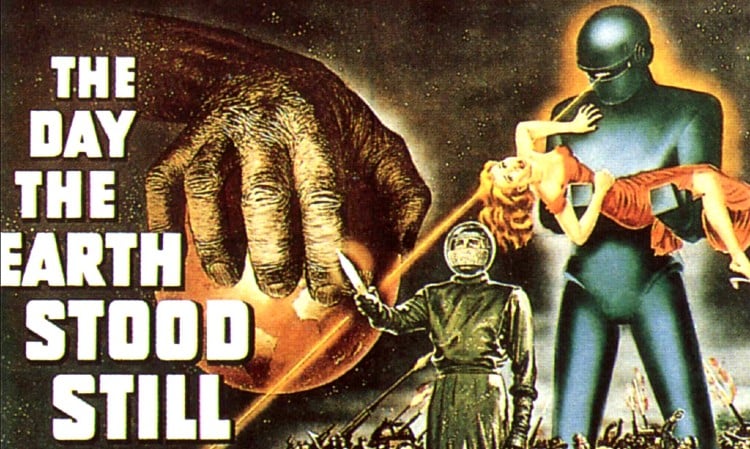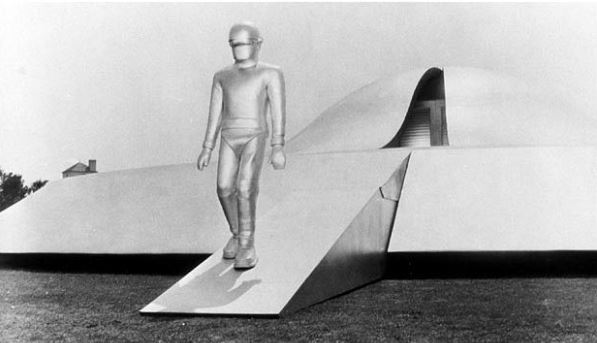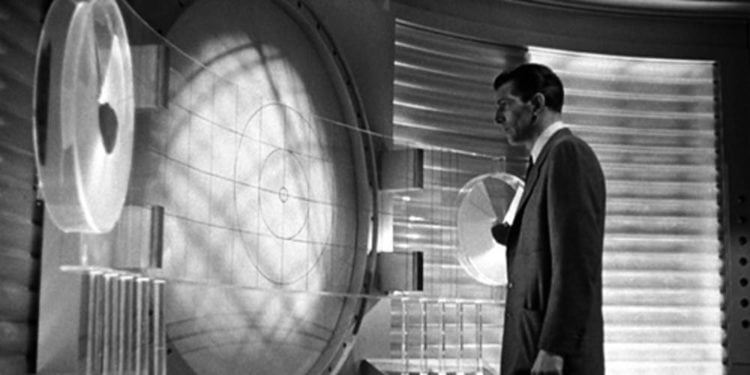
1951. WWII is finally over, but the Cold War is just beginning. NATO has been established to balance the Soviet Union threat to Europe and, on the other side of the planet, the Korean War has everyone worrying about communist threats to the West. In the midst of this escalating tension, science fiction writer Harry Bates publishes ‘Farewell to the Master,’ a hopeful story about an alien who comes to Earth to share a message of peace for all mankind. Robert Wise, later to direct ‘West Side Story,’ ‘The Sound of Music,’ ‘The Andromeda Strain,’ ‘Run Silent,’ ‘Run Deep’ and many other great films, decides to retool the story and create one of the great science fiction films: ‘The Day the Earth Stood Still.’
It’s a peaceful day on planet Earth when radars detect an object zooming overhead at 4,000 mph. Nothing made on Earth can travel that fast, so what is it? Alarmed newscasters share sighting information as it orbits the Earth. In Washington DC people are enjoying the nation’s capital when the object comes in and lands at the Washington Memorial: It’s a gleaming alien spaceship. The army promptly surrounds it with soldiers, tanks, and artillery, but when the ship finally disgorges a passenger, it’s an unassuming, completely humanoid Klaatu (Michael Rennie). When he offers a device to the military, a frightened young soldier accidentally shoots him. Klaatu falls to the ground, injured, and Gort (Lock Martin), a hulking 8-foot tall metal robot, storms out of the spaceship and vaporizes guns, tanks, artillery and anything else that it perceives as a potential threat.

Klaatu is brought to a military hospital where he tells the Secretary to the President that he urgently needs to address the leaders of all nations. That’s not possible, he learns to his dismay, as each leader insists that any meeting would have to occur in their sovereign territory. Stalemate. Instead, Klaatu sneaks out, assuming the identity of “Carpenter” and finds lodging at a DC boarding house. He’s going to live with people to learn more about them. He befriends Helen (Patricia Neal) and her typical American teen son Bobby (Billy Gray) and soon Bobby is leading Klaatu around Washington, including stops at Arlington National Cemetery and the Lincoln Memorial. Klaatu offers up thoughtful commentary about each, though it all goes over Bobby’s head.
Klaatu also learns that Professor Jacob Barnhardt (Sam Jaffe) is one of the smartest men in America and decides Barnhardt can help Klaatu talk to the heads of all the great nations. Klaatu informs Barnhardt that “the peoples of the other planets are concerned that humans have developed nuclear power” and that if Earth cannot attain peace, “Planet Earth will be destroyed.” As you might expect, convincing everyone else that “Carpenter” is actually the spaceman proves challenging, but he does, just to be the subject of a massive manhunt. He warns Helen that the robot Gort is actually quite dangerous and instructs her that the fail safe phrase is “klaatu barada nikto” then is promptly shot by overzealous US military personnel.
Gort resurrects Klaatu and, thanks to Helen’s recitation of the secret words, doesn’t destroy Earth. Finally, Klaatu heads back into his spaceship, warning that if the people of Earth extend their violence into space that the planet will have to be destroyed. “The decision rests with you.”

Good science fiction offers up an entertaining vision of an alternate present or future, but great science fiction addresses fundamental human questions, challenges or conundrums. Does God exist? Why are we here? What is life? What does it mean to be human? ‘The Day the Earth Stood Still’ wrestles with the human inclination to violence, suggesting that it will take an outside force to change that, if it can be changed at all. It’s also impossible not to notice the religious overtones of Klaatu’s story too, from his adopting “Carpenter” as his human name to his message of world peace to his death and subsequent resurrection. Wise always insisted that it was accidental, but it’s hard not to be a bit skeptical.
The message of peace is a critical element of the film too, and it’s worth noting that ‘The Day the Earth Stood Still’ actually won a Golden Globe award for “Best Film Promoting International Understanding”. Haven’t heard of it? The award was eliminated in 1964 after being awarded to ‘Lilies of the Field,’ starring a young Sidney Poitier.
‘The Day the Earth Stood Still’ remains a remarkable film that offers up a compelling and interesting story (and was dully remade in 2008 with Keanu Reeves as Klaatu, Jennifer Connelly as Helen and Jaden Smith as the young boy) that has been retold in many other science fiction films, great and mediocre. Steven Spielberg admits it contributed to his vision of ‘Close Encounters of the Third Kind’ (1977) and ‘E.T. The Extra-Terrestrial’ (1982) and it undoubtedly inspired two more great sci-fi films: ‘Contact‘ (1997) and ‘Arrival‘ (2016).

The 2008 remake with Keanu Reeves was frustrating to watch because, as with so many sci-fi remakes, the production team seems to have completely missed the point of the story entirely. Consider ‘Invasion of the Body Snatchers‘ for a minute. The 1956 original is a wonderfully claustrophobic tale about the group-think threat of communism. Chillingly, Dr. Bennell (Kevin McCarthy) famously warns viewers that “You’re next!” The 1978 remake gets so sidetracked by (admittedly far superior) special effects and the chemistry between Donald Sutherland (as Dr. Bennell) and Brooke Adams (as his love interest Elizabeth) that it completely misses the point of the film and ends up a flat, far less interesting movie. Ditto the Keanu remake of ‘The Day the Earth Stood Still.’ In classic sci-fi cinema, it’s never about the visual effects, it’s all about the story. Even cinematic masterpieces like ‘2001: A Space Odyssey,’ which is about the evolution of man, not space stations and monkeys banging animal bones. All the breathtaking visual effects are utilized to move the story forward, not as storytelling elements unto themselves.
Ultimately that’s why I so appreciate the 1951 version of ‘The Day the Earth Stood Still.’ With a modest budget and very few visual effects, it offers a compelling story that reverberates to this day. Laser satellites! Space Armies! Military bases on the moon and in Earth orbit! Indeed, it might be about time for Klaatu to show up and remind us to love one another and strive for world peace, not world war.
